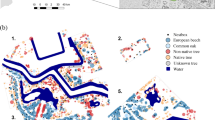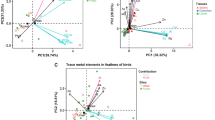Abstract
In urban areas the density of breeding tits (Paridae) is generally higher and reproductive performance lower compared to rural areas. To explain these landscape differences several hypotheses have been proposed, e.g. differences in habitat quality, inter- and intra-specific competition, predation and food abundance. How breeding performance of birds within remnants of natural vegetation in urban areas is affected by adjacent matrix has been less studied. We performed an experimental study in four urban woodlands surrounded by three types of habitat matrix: residential, high-rise building and grassland/golf course. We placed 300 nest boxes for tits (great tit Parus major and blue tit Cyanistes caeruleus) in 15 transects that were 200 m long, extending from the adjacent matrix 150 m into urban woodland. Density of breeding great tit pairs was highest in residential areas and hatch date was earlier in the residential habitat compared to the other two habitats, however, nestling condition was lower in residential areas. Hatching date was earlier but hatching spread (heaviest nestling/lightest nestling) higher in the three types of urban matrix than inside the urban woodlands. In contrast to previous large-scale comparisons of urban and rural matrix, we almost exclusively found differences in qualitative measures (nestling condition and hatchling spread) at the small scale in which this study was conducted. Adjacent matrix affect great tits breeding in remnant urban woodlands, thus we suggest that management of the surrounding matrix should be included in conservation plans for urban woodlands.




Similar content being viewed by others
References
Ardia DR (2005) Super size me: an experimental test of the factors affecting lipid content and the ability of residual body mass to predict lipid stores in nestling European Starling. Funct Ecol 19:414–420
Borgmann KL, Rodewald AD (2004) Nest predation in an urbanizing landscape: the role of exotic shrubs. Ecol Appl 14:1757–1765
Carlborg N (1991) Tätortsnära skogsbruk. The National Board of Forestry, Report 1, Jönköping (In Swedish)
Chamberlain DE, Cannon AR, Toms MP et al (2009) Avian productivity in urban landscapes: a review and meta-analysis. IBIS 151(1):1–18
Clergeau P, Jokimaki J, Savard JPL (2001) Are urban bird communities influenced by the bird diversity of adjacent landscapes? J Appl Ecol 38(5):1122–1134
Clergeau P, Croci S, Jokimäki J, Kaisanlahti-Jokimäki M-L, Dinetti M (2006) Avifauna homogenization by urbanization: Analysis at different European latitudes. Biol Conserv 127:336–344
Cowie RJ, Hinsley SA (1987) Breeding performance of blue tits and great tits in suburban gardens. Ardea 75:81–90
Crooks KR, Suarez AV, Bolger DT (2004) Avian assemblages along a gradient of urbanization in a highly fragmented landscape. Biol Conserv 115:451–462
Dhont AA, Adriaensen F (1999) Experiments on competition between Great and Blue tit: Effects on Blue tit reproductive performance and population processes. In: Adams NJ, Slotow RH (eds) Proc. 22 Int. Ornithol. Congr., Durban. Ostrich 70, 39–48
Eggers S, Griessier M, Andersson T, Ekman J (2005) Nest predation and habitat change interact to influence Siberian jay numbers. Oikos 111:150–158
Fraterrigo JM, Wiens JA (2005) Bird communities of the Colorado Rocky Mountains along a gradient of exurban development. Landsc Urban Plan 71:263–275
Friesen LE, Eagles PF, Mackay RJ (1995) Effects of residential development on forest-dwelling neotropical migrant sunbirds. Conserv Biol 9:1408–1414
Gärdenfors U (ed) (2010) The 2010 red list of Swedish species. Swedish Species Information Centre, SLU, Uppsala
Hedblom M, Söderström B (2008) Woodlands across Swedish urban gradients: Status, structure and management implications. Landsc Urban Plan 1:62–73
Hedblom M, Söderström B (2010) Landscape effects on birds in urban woodlands: an analysis of 34 Swedish cities. J Biogeogr 7:1302–1316
Hinsley SA, Hill RA, Bellamy PE, Harrison NM, Speakman JR, Wilson AK, Ferns PN (2008) Effects of structural functinal habitat gaps on breeding woodland birds: working harder for less. Landscape Ecol 23:615–626.
Hõrak P (1993) Low fledgling performance of urban Great Tits. Ornis Fennica 70:168–172
Hõrak P, Leberton J-M (1998) Survival of adult Great Tits Parus major in relation to sex and habitat, a comparison of urban and rural populations. Ibis 140:205–209
Hõrak P, Vellau H, Ots I, Møller AP (2000) Growth conditions affect caretenoid-based plumage coloration of great tit nestlings. Naturwissenschaften 87:460–464
Isaksson C, Örnborg J, Stephensen E, Andersson S (2005) Plasma gluthione and carotenoid coloration as potential biomarkers of environmental stress in great tits. EcoHealth 2:1–10
Jokimaki J, Kaisanlahti-Jokimaki ML (2003) Spatial similarity of urban bird communities: a multiscale approach. J Biogeogr 30(8):1183–1193
Jokimäki J, Suhonen J (1993) Effects of urbanization on the breeding bird species richness in Finland: a biogeographical comparison. Ornis Fennica 70:71–77
Jokimäki J, Kaisanlahti-Jokimäki M-L, Sorace A, Fernández-Juricic E, Rodriguez-Prieto I, Jimenez MD (2005) Evaluation of the “safe nesting zone” hypothesis across an urban gradient: a multi-scale study. Ecography 28:59–70
Konijnendijk CC (2003) A decade of urban forestry in Europe. For Policy Econ 5:173–186
Lepczyk CA, Mertig AG, Liu J (2003) Landowners and cat predation across rural-to-urban landscapes. Biol Conserv 1156:191–201
Marzluff JM (2001) Worldwide urbanization and its effects on birds. Avian ecology and conservation in an urbanizing world. In: Marzluff JM, Bowman R, Donnelly R (eds) Chapter 2, pp 19–49
Marzluff JM, Ewing K (2001) Restoration of fragmented landscapes for the conservation of birds: a general framework and specific recommendations for urbanizing landscapes. Restor Ecol 9:280–292
Melles S, Glenn S, Martin K (2003) Urban bird diversity and landscape complexity: Species-environment associations along a multiscale habitat gradient. Conservation Ecology 7:1. Article number 5
National Land Survey of Sweden (2001) Green Map. Lantmäteriverket. GSD Terrängkartan dnr 507-98-4720
Neave HM, Cunningham RB, Norton TW, Nix HA (1996) Biological inventory for conservation evaluation III. Relationships between birds, vegetation and environmental attributes in southern Australia. For Ecol Manag 85:197–218
Nilsson JÅ, Källander H (2006) Leafing phenology and timing of egg laying in great tits Parus major and blue tits P. caeruleus. J Avian Biol 37:357–363
Prevedello JA, Vieira MA (2010) Does the type of matrix matter? A quantitative review of the evidence. Biodivers Conserv 19:1205–1223
SAS Institute Inc (1999) SAS/User’s Guide, version 9.1. SAS Institute Inc, Cary
Sasvari L (1991) Territoriality in the Great tit Parus major at low and high densities. Bird Behav 9:88–93
Simon U, Kübler S, Böhmer J (2007) Analysis of breeding bird communities along an urban-rural gradient in Berlin, Germany, by Hasse Diagram Technique. Urban Ecosystems 10:17–28
Slagsvold T, Amundsen T (1992) Do great tits adjust hatching spread, egg size and offspring sex-ratio to changes in clutch size? J Anim Ecol 61:249–258
Solonen T (2001) Breeding of the Great Tit and Blue Tit in urban and rural habitats in southern Finland. Ornis Fennica 78:49–60
Sorace A (2002) High density of bird and pest species in urban habitats and the role of predator abundance. Ornis Fennica 79:60–71
SPSS (1999) Base 11.5 User’s guide. SPSS. Inc, USA
Svensson S (1996) Predation on birds by domestic cats in Sweden. Ornis Svecica 6:127–130 (In Swedish with English summary)
Tilghman NG (1987) Characteristics of urban woodlands affecting breeding bird diversity and abundance. Landsc Urban Plan 14:481–495
Uppsala Municipal Office (2007) www.uppsala.se (in Swedish)
Van Balen JH (1973) A comparative study of the breeding ecology of the great tit Parus major in different habitats. Ardea 61:1–93
Vogrin M (2000) Nest height and nesting losses of rural and urban Blackbirds Turdus merula. Ornis Fennica 10:149–154
Watson EM, Whittaker RJ, Freudenberger D (2005) Bird community responses to habitat fragmentation: how consistent are they across landscapes? J Biogeogr 32:1353–1370
Acknowledgement
The study was financed by the Swedish research council FORMAS. We thank Åke Berg, Sönke Eggers, Tobias Jeppsson, Karin Perhans, Tomas Pärt and Jean-Michel Roberge at the Department of Ecology for giving helpful advice on how to improve the paper. Thanks to Lennart Norell for help with the logit regression and mixed model statistics. A special thanks to the 50 families allowing us to use their gardens as experimental areas, Erik Gustafsson for providing nest boxes and Ian Henshow for correction of English language.
Author information
Authors and Affiliations
Corresponding author
Rights and permissions
About this article
Cite this article
Hedblom, M., Söderström, B. Effects of urban matrix on reproductive performance of Great Tit (Parus major) in urban woodlands. Urban Ecosyst 15, 167–180 (2012). https://doi.org/10.1007/s11252-011-0204-5
Published:
Issue Date:
DOI: https://doi.org/10.1007/s11252-011-0204-5




